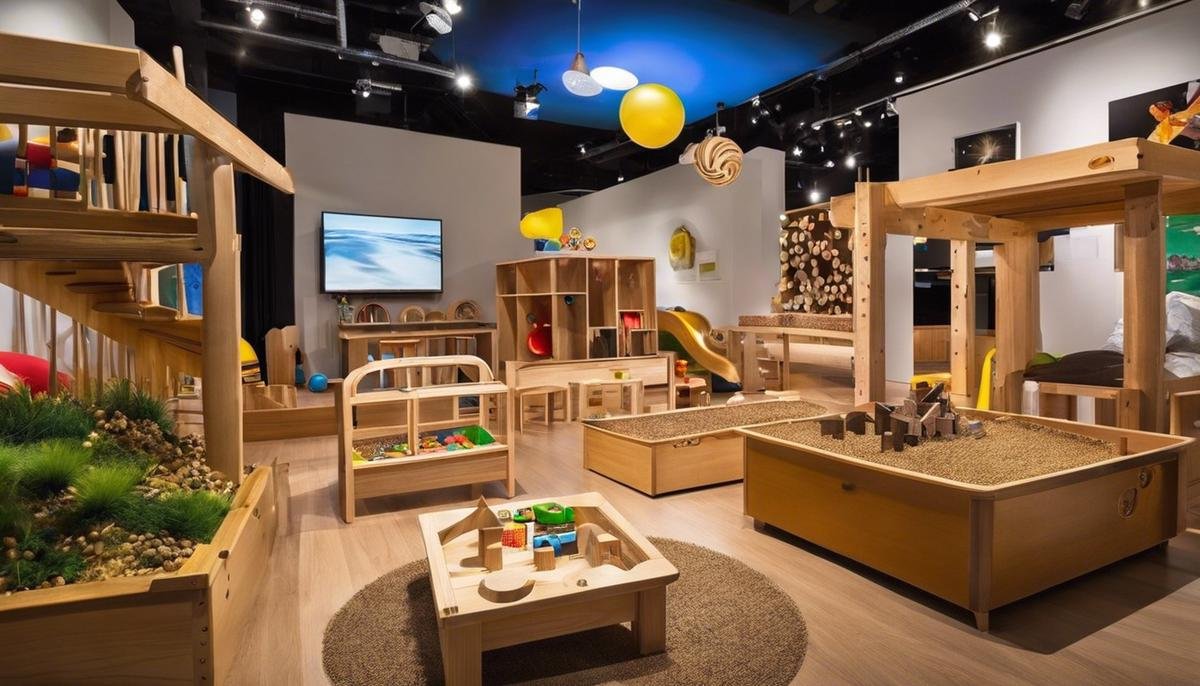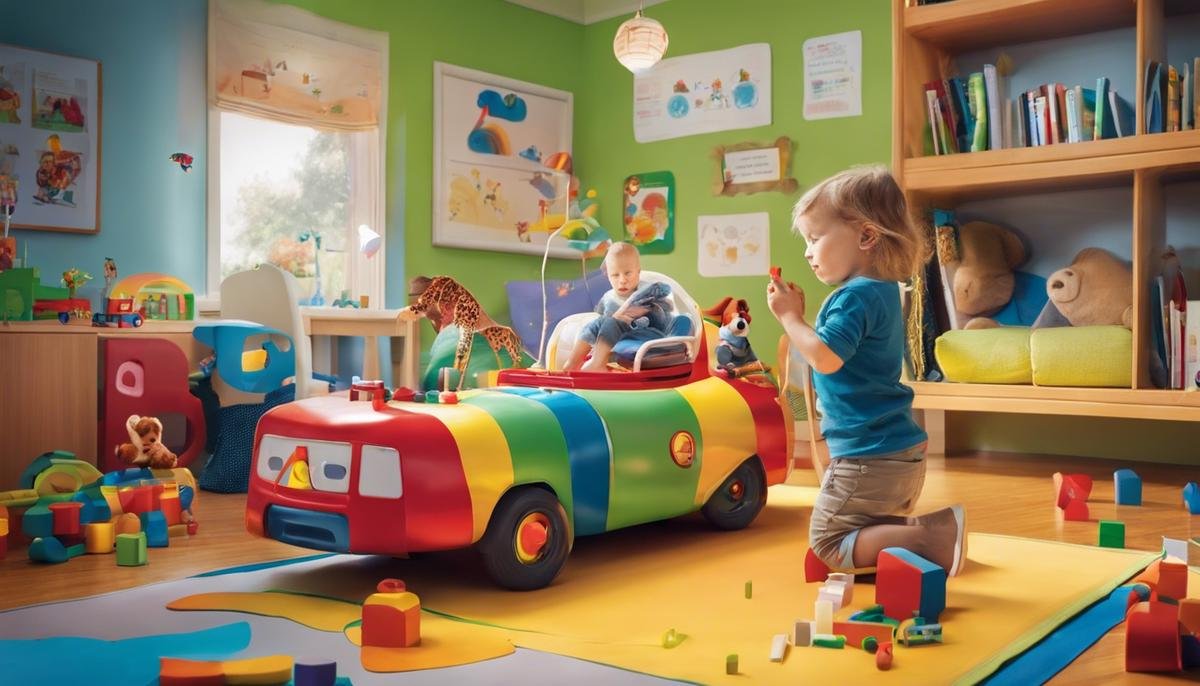
Sensory Processing Disorder (SPD) is a complex condition that can profoundly affect individuals with autism, manifesting through heightened or diminished sensitivity to sensory inputs that most of us effortlessly filter and understand. For children embarking on life’s journey with the twin challenges of SPD and autism, the world can feel like an unpredictable cascade of sensory stimuli. Understanding the bewildering experience of SPD is critical not only for professionals who provide diagnosis and treatment but also for families seeking to create nurturing and accommodating environments. Delving into the nuances of how SPD intersects with autism, this discussion illuminates the overlapping currents of sensory challenges that can shape a child’s behavior and responses, setting the stage for a conversation about the multifaceted approach to treatment and support.
Understanding Sensory Processing Disorder (SPD) in Autism
Navigating the Sensory World: Understanding SPD in Children with Autism
Hey there, wonderful parents and caregivers!
Have you ever noticed your child covering their ears at the sound of a vacuum cleaner or refusing to wear certain clothes because of how they feel? Well, these might be more than just quirky behaviors – they could be signs of Sensory Processing Disorder (SPD). For families blessed with a child on the autism spectrum, understanding SPD becomes a critical part of the journey.
SPD is a condition where the brain struggles to accurately process the information coming in from the senses. It’s like a traffic jam on the sensory highway, where signals get mixed up or misinterpreted. This can make the world an overwhelming place for these kiddos.
For a child with autism, SPD might manifest in several ways:
- Hypersensitivity (Sensory Avoidance): These are the little ones who wear their favorite soft t-shirts day in and day out and might meltdown under bright lights or loud noises. They might avoid certain textures or tastes, representing an overly delicate radar for sensory input.
- Hyposensitivity (Sensory Seeking): Ever watched in awe as a child with autism seems oblivious to pain, or craves intense sensory experiences? They might be constantly touching objects or people, seeking tight hugs, or even enjoy spinning in circles. It’s all about an under-sensitive sensory processing system.
- Poor Sensory Discrimination: Some children may have trouble pinpointing where a touch or a sound is coming from, or they may struggle with tasks that require precise movements, like buttoning a shirt or using scissors.
- Sensory-Based Motor Skills Problems: Difficulty coordinating movements can be linked to SPD. This could manifest in two different ways – postural disorder (trouble stabilizing the body during movement or rest) or dyspraxia (challenges planning and executing nonhabitual motor tasks).
- Social and Emotional Difficulties: When a child’s senses are going haywire, it can be hard for them to engage in play or social interactions. They might also exhibit anxiety or outbursts due to the overwhelming sensations they’re experiencing.
Now, how does one manage these sensory difficulties? Strategies are as diverse as our amazing children, but here are some general approaches:
- Sensory diet: Creating a personalized activity plan that provides the sensory input a child needs to stay balanced and organized throughout the day.
- Environmental modifications: Sometimes, just reducing ambient noise or changing lighting can make a world of difference.
- Occupational therapy: A therapist specializing in sensory integration can work wonders, guiding these children toward better processing and integration of sensory information.
Cultivating a supportive and understanding environment at home and school means the world to these children. It also helps to educate family members and peers about SPD, creating a nurturing community where our children can thrive.
Remember that every child is unique, and SPD will look different from one child to the next. It’s about tuning into those personal experiences and helping to make the sensory world a more navigable place for them. Through patience, love, and some clever strategies, we not only help our children manage their sensory experiences but also celebrate the vibrant individuals they are. Keep shining, keep supporting, and let’s continue building a beautiful tapestry that honors all the different ways our children experience the world.

Assessment and Diagnosis of SPD
When it comes to obtaining a diagnosis for Sensory Processing Disorder (SPD), knowledge is power. Parents often find themselves as the first observers of their child’s struggles with sensory integration. Understanding the process of getting an SPD diagnosis can significantly ease the path ahead for both the child and the family.
The starting point typically begins at home, noticing and documenting patterns that raise concerns. This proactive step is crucial, as it provides concrete examples to share with professionals later on. The following steps outline how to navigate the journey toward diagnosis and assessment:
- Schedule a Pediatrician Visit: A visit to the child’s primary care physician is a foundational step. Explain the concerns using the documented instances. The pediatrician may screen for SPD using checklists or questionnaires and refer the child to a specialist if SPD is suspected.
- Seek a Specialist: Many times, a referral to an occupational therapist (OT) with experience in sensory processing issues is recommended. Pediatric occupational therapists are skilled in evaluating sensory processing and can perform a thorough assessment of the child’s sensory needs.
- The Evaluation Process: An OT will typically use standardized assessment tools combined with clinical observations to evaluate how the child responds to sensory experiences. Tools like the Sensory Integration and Praxis Tests (SIPT) or Sensory Processing Measure (SPM) are commonly employed. These tests help to discern patterns of sensory processing and provide a comprehensive view of the child’s sensory profile.
- Provide a Full History: Parents will be asked to give a detailed history of the child’s development and behaviors. This includes medical, social, and family history, which can provide context to the child’s sensory processing patterns.
- Collaborative Approach: It’s important to work with the OT and other professionals as part of a team. Collaboration ensures that all aspects of the child’s health and well-being are taken into consideration during the diagnostic process.
- Create an Intervention Plan: After an SPD diagnosis, the OT will collaborate with parents to create a tailored intervention plan. This may include therapy sessions focusing on sensory integration techniques, advice on home modifications, and strategies for parents and educators to support the child’s sensory needs.
- Consider Additional Evaluations: In some cases, other assessments may be advised to rule out or address coexisting conditions. A comprehensive assessment ensures that all of the child’s needs are identified and met.
- Follow Up and Adjust: Sensory processing can change over time, so it’s important to stay in contact with the OT for ongoing support. Regular evaluations can help to adjust the child’s intervention plan as they grow and develop.
Moving towards a formal diagnosis of SPD is a journey, but parents are not alone. Occupational therapists, pediatricians, and other parents who have navigated this path offer invaluable support. Armed with information, compassion, and a team-centric approach, a proper assessment is within reach, paving the way for the necessary steps to support a child’s sensory growth and overall well-being.

Occupational Therapy Techniques
Embarking on the journey to support a child with Sensory Processing Disorder (SPD) and autism involves a spectrum of therapeutic strategies that can wonderfully enhance their ability to navigate daily life. As nurturing guides, it is vital to lean into occupational therapy (OT) techniques that can be immensely beneficial for these amazing kids.
Occupational therapy stands out as a beacon, offering targeted interventions that help children engage more fully with the world around them. One particularly effective OT technique is sensory integration therapy. This involves creating structured and unstructured activities that challenge a child’s ability to respond appropriately to sensory input. This method can help children who struggle to process and act upon information received through the senses, ultimately fostering greater independence and confidence in their abilities.
Another cornerstone of occupational therapy is the use of play-based therapy. This technique is cloaked in fun but is a hard worker behind the scenes, targeting developmental areas through games and activities that children naturally enjoy. Through play, children with SPD and autism can improve their social interactions, communication, motor skills, and problem-solving abilities all while in the comfort of fun, relatable contexts.
Structured and repetitive activities are a valuable OT technique for kids with SPD and autism who crave predictability and routine. These activities help in establishing a sense of order and safety that can reduce anxiety and enable children to learn and practice new skills within a secure framework.
Occupational therapists also often employ the use of assistive technology, such as communication devices or apps specifically designed to aid in daily functioning. These tools can empower children with SPD and autism to communicate more effectively, manage sensory overload, and learn new skills at a pace tailored for their individual needs.
Finally, collaboration with families to establish home programing is a key advantage of OT. Therapists can guide families in creating supportive home environments that extend the benefits of therapy sessions. This might include the development of visual supports to aid in transitions and routines, the creation of sensory-friendly play areas, or strategies for managing behaviors that make daily activities smoother for everyone involved.
As families journey alongside their children with SPD and autism, occupational therapy shines as a multifaceted ally. Through its many techniques, OT not only fosters essential skills but also champions the resilience and capabilities within each child, celebrating their unique contributions to the family tapestry. With dedication and teamwork, the possibilities are boundless, as our children reach new milestones and flourish in their own extraordinary ways.

Integrative Therapies for SPD
Navigating the world of additional therapies to complement occupational therapy for children with SPD on the autism spectrum can seem overwhelming at first, but fear not! Imagine a puzzle where each piece supports another, creating a complete, supportive picture for our kiddos. There are several effective therapies out there that can fill in the gaps and bolster the progress children make through occupational therapy.
Music Therapy
Harmony for the Senses
Music has a universal appeal, and music therapy is an excellent avenue for children with SPD. It uses musical interaction to aid in the development of communication, social, and motor skills. Plus, the rhythm can provide a soothing structure that helps kids with SPD process sensory information more effectively. Bonus points: it’s also a fun way for families to bond through shared musical activities!
Speech and Language Therapy
Communication is Key
Kids with SPD often face challenges in communication, and that’s where speech and language therapy comes into play. By working on speech patterns, language skills, and even nonverbal communication, this therapy complements occupational therapy by broadening the mechanisms through which children can express and understand their sensory experiences.
Behavioral Therapy
Positive Strategies and Coping Skills
Having a behavioral therapist on board offers families strategies for managing challenging behaviors that may be linked to sensory overload. This type of therapy can help children with SPD learn how to cope with their emotions and reactions in a safe and nurturing environment while enhancing their social skills.
Physical Therapy
Building Strength and Coordination
While occupational therapy addresses the daily living skills, physical therapy can be instrumental for children with sensory-based motor skills issues. It targets the development of gross motor skills, strength, and coordination, which are often areas of difficulty for kids on the autism spectrum with SPD.
Feeding Therapy
Savoring Each Bite
Many of us overlook the complex sensory experience involved in eating. For children with SPD, feeding therapy can be a game-changer. It helps them cope with textures, tastes, and smells that may otherwise be overwhelming, turning mealtime from a source of stress into a more pleasurable experience.
Therapeutic Riding
Horsing Around for Growth
Equine therapy, or therapeutic riding, provides children with SPD a unique sensory experience that can improve balance, coordination, and emotional connection. The motion of the horse can be particularly calming for some kiddos, giving them an enjoyable sensory input while they work on physical and emotional goals.
Mindfulness and Relaxation Techniques
Calm Amidst the Sensory Storm
Teaching children with SPD mindfulness and relaxation techniques equips them with methods to calm their minds and self-regulate. Techniques like deep breathing, guided imagery, or progressive muscle relaxation can be lifesavers during times of sensory overload.
Remember, dear reader, the importance of tailoring additional therapies to suit the individual needs and preferences of each child. Keep those lines of communication open with therapists and caregivers to find the symphony of therapies that best support the occupational therapy journey. Here’s to each family finding the pieces that fit just right for their special and unique child’s puzzle. With patience, love, and the right combination of therapies, our children with SPD can thrive in their own extraordinary ways.

Parenting Strategies and Home Environment Adjustments
Creating a Comforting Home Space for Children with Autism and Sensory Processing Disorder
As our understanding of Autism Spectrum Disorder and Sensory Processing Disorder (SPD) grows, so does the realization of the profound impact our home environment has on our affected children. Adjusting our homes to better suit their needs can be a game-changer, providing them with a sanctuary that accommodates their unique sensory preferences and challenges. It’s not about a one-size-fits-all solution; it’s about tailoring our spaces to embrace and celebrate our children’s distinct ways of experiencing the world.
Let’s talk zones. Designate specific areas in your home for various activities. Create a calm-down zone: a low-stimulation space filled with cushions, weighted blankets, or a beanbag chair, allowing for a peaceful retreat when the world gets overwhelming. For the sensory seekers, a play zone with therapy balls, swings, or a small trampoline can provide the necessary outlet for their boundless energy and need for movement.
Lighting matters. For some children, the hum and flicker of fluorescent lights are just too much. Opt for natural lighting where possible, and consider using lamps with adjustable settings or LED lights that provide a steady, silent source of illumination. Soft, warm lights often work best to create an inviting and soothing atmosphere.
Think about textures. From the carpets on the floor to the throws on the sofa, the tactile experience of your home can be a source of comfort or distress. Fuzzy rugs, smooth satin pillows, and soft cotton blankets can offer valuable sensory feedback without being overwhelming.
Mealtime can be tricky, but it’s also an opportunity to encourage positive sensory experiences. Use compartmentalized plates to keep foods from touching, and have utensils that feel comfortable in your child’s hands. Some children prefer certain colors or designs on their tableware—embrace it! It’s all part of making them feel comfortable and accepted in their environment.
Now to the nitty-gritty—organization and predictability are crucial. Clear, labeled bins for toys and belongings help reduce anxiety by offering a visual structure. Daily routines and visual schedules can assist in establishing a sense of order and expectation, which is especially beneficial for children who may struggle with transitions.
Implementing a “no surprise” policy can go a long way. This means preparing your child in advance for any changes in the home or schedule, whether it’s a new piece of furniture or a visitor coming over. Giving your child time to adjust at their own pace can make a world of difference.
Most importantly, the family home should be a collaborative space. This includes involving your child in choosing comfort items or picking out colors for their room. Their input is invaluable because, after all, they’re the ones we’re customizing these spaces for.
A home is more than just a place to live; it’s a haven where our children can feel safe, understood, and loved. With mindful adjustments and a heart full of empathy, we can nourish the development and well-being of our children with autism and SPD, supporting them in blossoming to their full potential. Let’s cherish every step of this remarkable journey together.

As we’ve explored the varied landscape of SPD treatments and strategies, it’s evident that supporting a child with SPD and autism is a journey that embodies adaptation, compassion, and continuous learning. Occupational therapy stands as a cornerstone in this therapeutic structure, melding seamlessly with integrative treatments and home-based strategies to create a holistic approach to managing sensory challenges. The parenting journey involves transforming ordinary spaces into sensory havens, where children feel safe and understood – a reflection of the profound empathy that guides the heart of each family. It is through this symphony of efforts—from clinical interventions to the smallest environmental adjustments—that children with SPD find their unique rhythm in the sensory-rich dance of life, opening doors to growth, connection, and a fuller experience of the world.




